Altan T. Metal Forming Handbook
Подождите немного. Документ загружается.


When producing small sheet metal components such as drawer
slides, disc carriers for automatic transmissions, wishbones, bicycle
brake levers etc., the coil stock can be fed directly to the press by a coil
line (cf. Fig. 4.3.1).The sheet metal forming process takes place in a com-
pact piece of equipment, generally a high-speed press (cf.Fig.4.6.6),a
universal (cf. Fig. 4.4.1)or transfer press (cf. Fig. 4.4.23).
The finished parts are palletized either manually or by using a stack-
ing device (cf. Fig. 4.4.41)and made ready for downstream processing,
for example welding, painting or hemming. At the same time, scrap dis-
posal takes place.
For the introduction of new dies for large parts and transfer presses,
try-out presses (cf.Fig.4.1.19and4.1.20)and simulators (cf.Fig.4.1.24)
are employed. These are used by the die shop to prepare tooling as well
as try-out of the dies before the final try-out on the actual production
press.
This shortens the die try-out time on the production presses sub-
stantially for obtaining the first OK parts. Consequently, this procedure
shortens the time necessary to produce the first OK parts and increases
the machine utilization rate.
4.9.2Layout
The following provides a detailed description of a typical example stamp-
ing plant layout. To simplify matters somewhat, our explanation is based
on the assumption of ideal conditions and new installation of the com-
plete equipment (Greenfield plant). This is a typical task to establish
manufacturing facilities for the production of medium-sized and large
car body panels such as doors, roofs, hoods, floor panels, side panels,
fenders etc. for a particular car type. There are three press systems avail-
able: tri-axis transfer presses (cf. Fig. 4.4.27),crossbar transfer presses (cf.
Fig. 4.4.38)and press lines (cf. Fig. 4.4.19)of various bed sizes.
Before preparing the plant layout, it is first necessary to determine
which parts are to be outsourced and which are produced in-house. The
following parts are generally produced in-house:
–outer panels whose surface could be damaged during transport,
–joining parts with narrow gap tolerances for precise matching,
–parts of large volume resp. size which are difficult to stack or transport.
391
Organization of stamping plants
Metal Forming Handbook / Schuler (c) Springer-Verlag Berlin Heidelberg 1998
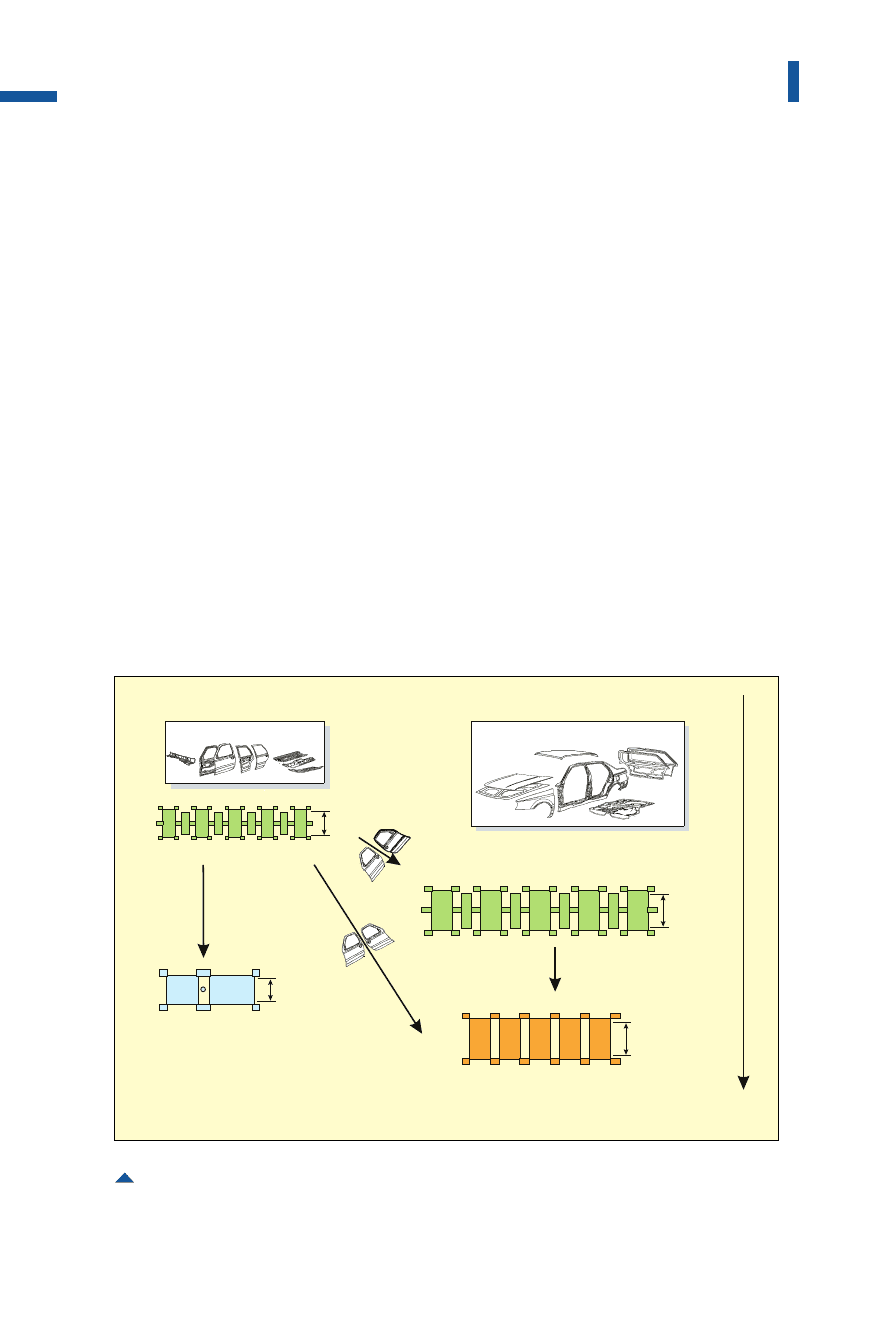
392
Sheet metal forming and blanking
These so-called A-parts – there are generally between 30 and 40 of
them per vehicle type – must be grouped together to families of parts.
These are then allocated to the different press systems on which they
can be economically manufactured.
Figure 4.9.2and Table 4.9.1 illustrate the correlation between part size
and press system. When processing medium-sized panels, a press line with
a medium bed size or a tri-axis transfer press will be employed. Press lines
with large bed sizes or crossbar transfer presses offer the ideal conditions
for processing large panels with low inherent stiffness or double panels.
Figure 4.9.3offers a more precise allocation of parts to both available
transfer press systems. Some parts can be handled by crossbars with
suction cups as well as by gripper rail systems. They represent the
overlap between two families of parts. Some of these parts, such as
doors, are produced as single parts using gripper rail transfer systems
(cf.Fig.4.4.29)or as double parts using a crossbar transfer system
(cf.Fig.4.4.34).
Fig. 4.9.2 Press systems for the manufacture of car body parts
medium dimension:
tri-axis transfer press
crossbar transfer press
press line
press line
typical family of parts
large dimension:
typical family of parts
up to 3,000 mm
up to 5,000 mm
time
up to 5,000 mm
up to 3,000 mm
Metal Forming Handbook / Schuler (c) Springer-Verlag Berlin Heidelberg 1998

393
Organization of stamping plants
The selection and loading of presses depend primarily on the num-
ber of vehicles to be produced. The number of vehicles determines the
production requirement of all parts per day. If the A-parts of a vehicle
type are manufactured on large-panel transfer presses, the stamping
plant must have a capacity of between 3 and 4 million parts per year
(basis of planning: 1 vehicle type = 100,000 vehicles per year).
The production scope per year, i.e. the number of parts which can be
produced on the press system per year, must be co-ordinated with the
production requirement. This calls for an output analysis of the indi-
vidual press system. The basis for calculation is the production stroking
rate. In transfer presses, this is equivalent to the stroking rate set at the
press. In the case of press lines, the production stroking rate is reduced
to some 50% to 60% of the set press stroking rate due to standstill peri-
ods caused by the single stroke operation. The number of parts which
can be produced during press operation also depends on the forming
requirements of the individual parts. A complex part requires a longer
processing time. In addition, the time necessary for transportation of
Table 4.9.1: Criteria for press selection
large-panel transfer presses
press lines
with differing
bed sizes
part spectrum
medium-sized parts all parts
++ + 0
0+++
+++ 0
10 10 30
crossbar
transfer
tri-axis
transfer
large, unstable parts
and double parts
complete part
production
low
investment
low space
requirement
die change
time [min.]
Metal Forming Handbook / Schuler (c) Springer-Verlag Berlin Heidelberg 1998
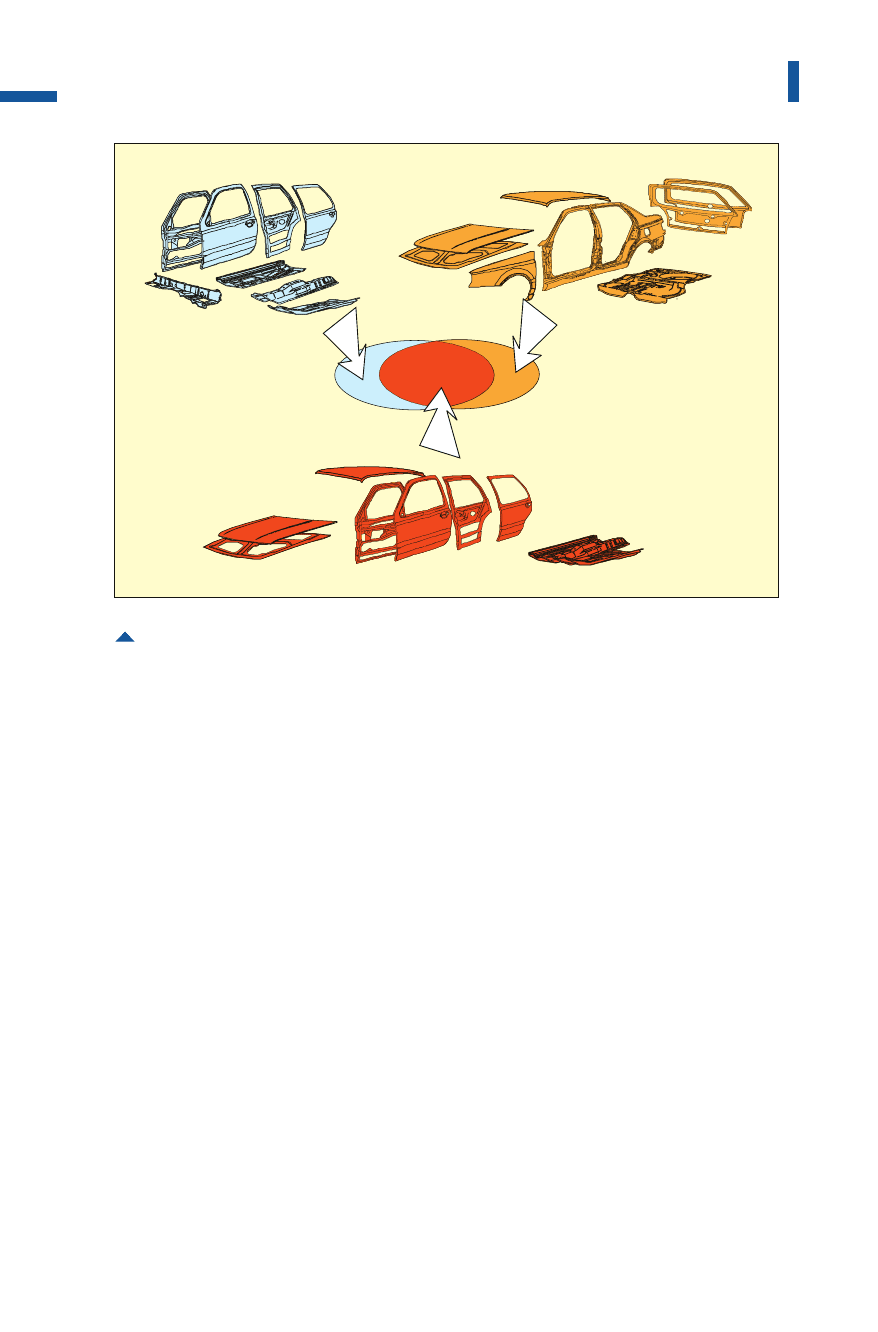
394
Sheet metal forming and blanking
large, unstable parts increases. Because of its range of parts and longer
feed pitch, a crossbar transfer press is not able to run at the same high
stroking rates as a tri-axis transfer press. In general, it is true to say that
the output of a press system must always be considered in the light of
the part family planned for production on the press.
In case of double part production in a crossbar press the processing
time per part is reduced. When double dies are used, the average output
of a crossbar transfer press is larger than the output of a tri-axis transfer
press using single dies, despite of the fact that the average production
stroking rate is lower. Double dies are preferred for the manufacture of
outer and inner doors, front and rear, left and right. Where 10 doors per
minute can be produced on a tri-axis transfer press, for instance, the
output of a crossbar transfer press can be increased by 50% to 15 parts
per minute.
The number of hours worked also plays an important role in calculating
the production level, based for example on the number of days worked per
week, the length of the seasonal shut downs and shut downs due to pub-
Fig. 4.9.3 Families of parts for large-panel transfer presses with different transfer systems
tri-axis transfer
crossbar transfer
Metal Forming Handbook / Schuler (c) Springer-Verlag Berlin Heidelberg 1998

lic holidays which vary from country to country. Let us assume between
200 and 300 effective days’ work per year and daily working periods of
between 840 and 1,260 min depending on two or three-shift operation.
Then the annual production capacity fluctuates between 100% at the low-
er end and 225% at the higher end. Major influencing factors which can-
not be freely selected by the manufacturer, such as statutory labor legisla-
tion, collective agreements etc. may determine the possible framework.
This means that production capacity must always be calculated relative to
personnel requirements.
Other influencing factors include for example necessary production
system maintenance intervals. If the stamping plant operates at full
capacity, these periods may have to be deducted from the production
capacity. In case a five day week is worked, maintenance can be done
on Saturdays and Sundays without loss of production.
If we reduce the working time by the periods in which no production
takes place, we arrive at the press availability or uptime. Particular factors
which must be planned for during working hours include for example die
change, die setting or die cleaning times. In addition to scheduled press
stops, unscheduled downtime must also be allowed for. This can be caused,
for example, by failure of the blank supply, press or dies. Overall, the
uptime of modern large-panel transfer presses is generally in the range of
70% of the total available work time (Fig. 4.9.4).The actual average line
output is thus calculated from the production stroking rate, the press oper-
ation time and the proportion of press running time during which double
parts are produced. Extrapolated over a whole year, values of up to 4.3 mil-
lion parts may result, depending on the press system and working hours.
Table 4.9.2 illustrates an example of output for a production system com-
prising a blanking line and two large-panel transfer presses. Providing that
double parts are produced for 50% of the time on the crossbar transfer
press, with a total of around 3.9 million production strokes of the transfer
presses per year, we arrive at an output of 4.8 million sheet metal parts per
year.
When generating a press load schedule, batch sizes and the produc-
tion sequence are defined. The sequence is repeated within each com-
plete cycle, whereby a part can be produced several times during any
one cycle. Figure 4.9.5illustrates an example of a press load schedule
and the relevant inventory in the intermediate storage of finished parts
for the production of four different sheet metal parts. Parts A and B are
395
Organization of stamping plants
Metal Forming Handbook / Schuler (c) Springer-Verlag Berlin Heidelberg 1998
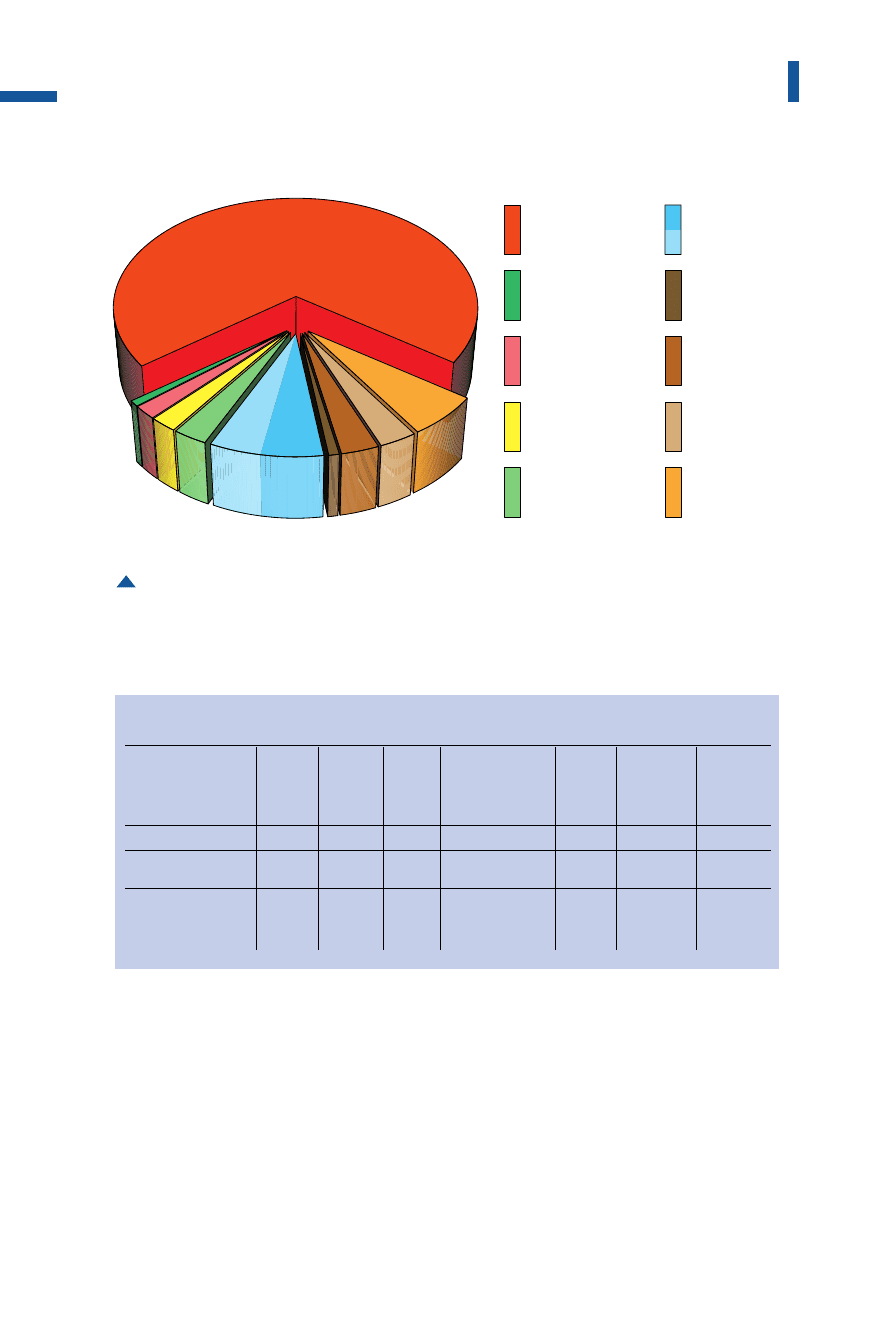
396
Sheet metal forming and blanking
each manufactured twice in one cycle with batch sizes of 5,000 and
3,000, while type C and D parts are only produced once in a cycle with
batch sizes of 4,800 and 3,300 respectively. During production, the
inventory of the relevant part increases in the intermediate storage.
However, at the same time parts are removed (illustrated in Fig.4.9.5
for part A). The steeper the production curve, the shorter the processing
Fig. 4.9.4 Availability and downtimes of large-panel transfer presses
availability
70%
organization
1%
part-specific
tooling
2%
blank logistics
3%
die cleaning
5%
dies 4%
transfer
1%
blankloader
3%
press
3%
die change
6%
blanks
2%
Table 4.9.2: Actual part output of a blanking line and two large-panel transfer presses
blanking line 20 ... 55 27 65 17.5 80 3,916,000 3,916,000
12 ... 16 14 70 9.8 80 2,193,000 2,193,000
10 ... 12 11 70 80 2,584,500 1,723,000
crossbar transfer press
50 % single dies,
50 % double dies
tri-axis transfer press
set stroking
rate
[1/min]
average
production
stroking
rate
[1/min]
availability
[%]
net output
[parts/min]
planned
utilization
rate
[%]
output with
1,260 min
working period
on 222 days/
year
strokes/year
resp.
blanks/year
single dies 7.7
double dies 15.4
average 11.55
Metal Forming Handbook / Schuler (c) Springer-Verlag Berlin Heidelberg 1998
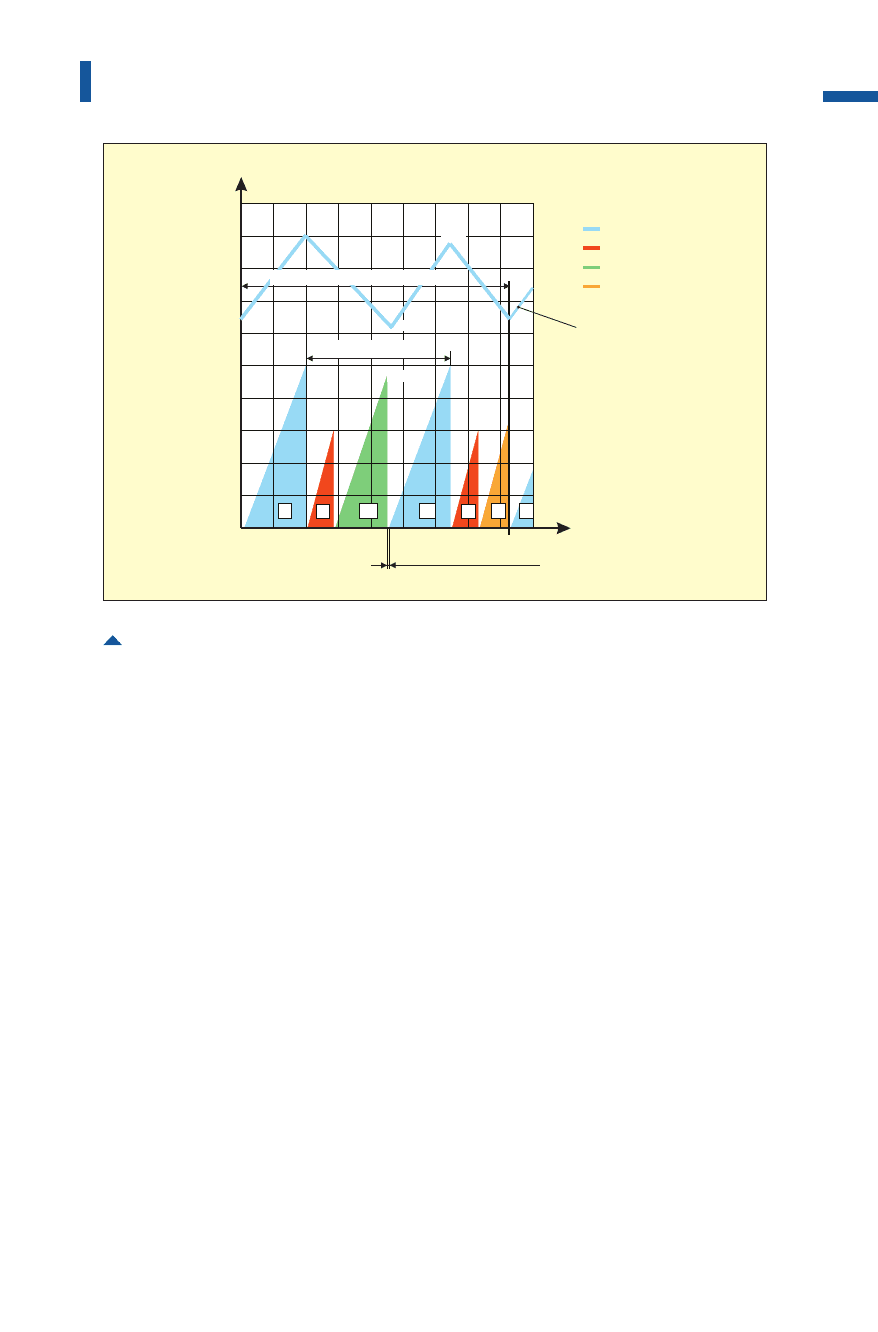
397
Organization of stamping plants
time per part. Die changes and setting of new dies takes place within
press stops between production, whereby the die changing time plays
an important role (cf. Sect. 3.4).
Production must be resumed once the storage drops to the defined
safety inventory level, generally one day’s production. If we take type A,
for example, this level would be reached at 6,200 pieces, while for type
B the corresponding figure is 2,800 pieces. The 5,000 or 3,000 parts pro-
duced, less the parts used during manufacture, must last until the next
planned production period – around 14 resp. 22 hours later. When com-
piling the load schedule, a fine balance must be drawn: On the one hand
the production period for a batch size has to guarantee sufficient time
for set-up of the die set for the next part. At the same time, however,
excessively large batch sizes violate the principle of just-in-time produc-
tion in terms of capital costs for work-in-process and costs for interme-
diate storage of finished parts.
Fig. 4.9.5 Load schedule and parts inventory for production on a large-panel transfer press
inventory of finished parts
in the intermediate storage
for part A
part A: 7 p/min
part B: 10 p/min
part C: 8 p/min
part A: 11 p/min
daily working hours:
15 hours
time [hours]
10 min die change after each batch
batch size [pcs.]
production cycle: ABCABD
10,000
8,000
6,000
4,000
2,000
61218243036424856
production cycle of 50 hours
A
A
B
C
A
B
D
6,400
9,000
6,200
8,800
6,400
4,800
3,300
part cycle A
Metal Forming Handbook / Schuler (c) Springer-Verlag Berlin Heidelberg 1998

398
Sheet metal forming and blanking
Example:
A production unit has to be configured in which 44 pressed parts – primarily A
parts – have to be produced every year for 100,000 vehicles. The unit comprises
a blanking line, a crossbar transfer press and a tri-axis transfer press. A possible
configuration of this stamping plant with optimized material flow and periph-
eral devices is illustrated in Fig. 4.9.6.The material is supplied in the form of coil
stock and stored in the coil storage, from where it is fed to the blanking line.
This supplies through the blank storage both large-panel transfer presses with a
total of 4 million blanks a year. Following production on the transfer presses,
the parts are transported in part-specific racks to the intermediate storage for
finished parts.
Table 4.9.3 lists the part spectrum for both forming presses. The crossbar trans-
fer press is run using eight individual and eight double die sets, whereby the
double dies in this example always produce two different parts. Their die
change time amounts to 10 min. The tri-axis transfer press manufactures 20 dif-
ferent parts using 20 die sets. The die change time is also 10 min. Overall, the 44
parts are produced using 36 sets of dies – 20 on the tri-axis transfer press, and 24
on the crossbar transfer press.
If 222 working days are available per year, parts for 450 vehicles must be pro-
duced every day. In three-shift operation with working periods of 1,260 min per
day, the total of approx. 4.8 million parts indicated in Table 4.9.2 (achieved
with 3.9 million strokes) can be produced every year on the transfer presses.
This is based on a planned capacity utilization of 80%. Three days are selected
as a production cycle. If we take the simplified assumption that every part is
only run once per cycle, three times 450 parts must be produced per cycle. The
intermediate storage for finished parts has a theoretical maximum inventory of
1,800 pressed parts of each part type: 1,350 parts from running production plus
450 parts as a minimum safety inventory. On average, however, as body-in-
white production runs on a parallel basis, only around half of the parts are
located in the intermediate storage. At any point in time, the inventory com-
prises 900 344, i.e. approx. 40,000 parts. As a result, the part storage and the
capital investment this involves are considerably lower than when producing
on conventional press lines.
4.9.3Quality assurance through quality control
The aim of achieving zero-defect production calls for continuous qual-
ity control. This involves the detection of any changes in the produc-
tion process which could precede a defect, and the segregation of indi-
vidual defective parts. Conventional methods of quality assurance in
stamping plants include visual inspections – in the case of deep drawn
Metal Forming Handbook / Schuler (c) Springer-Verlag Berlin Heidelberg 1998
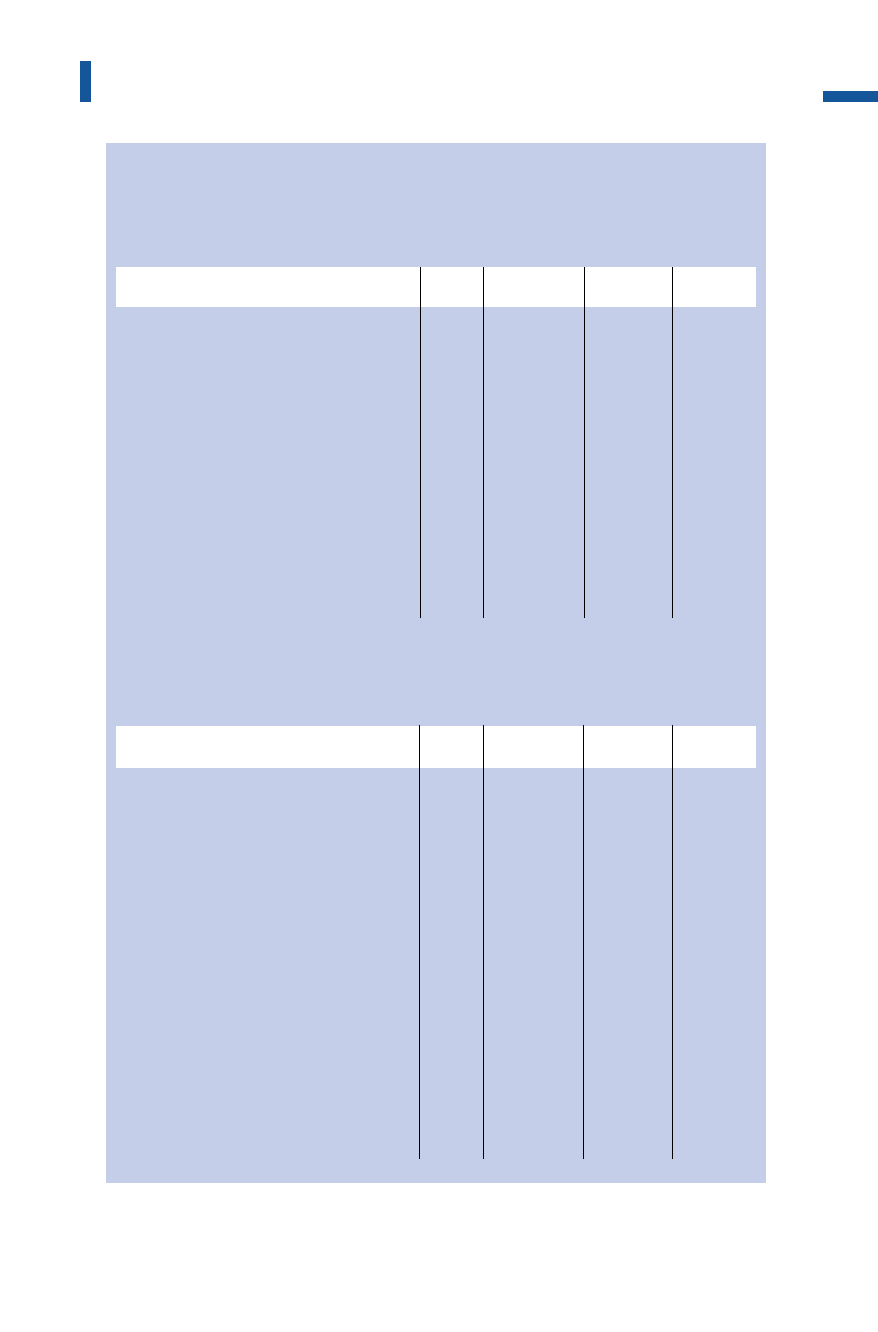
Crossbar transfer press
Parts/ Part require-
Part name
stroke ment/day
body side, outer, right
1 450 1350
body side, outer, left
1 450 1350
door, outer, front, right + left
2 450 1350
trunk lid, inner
1 450 1350
roof
1 450 1350
trunk lid, outer
1 450 1350
door, inner, front, right + left
2 450 1350
body side, inner, rear, right + left
2 450 1350
door, outer, rear, right + left
2 450 1350
door, inner, rear,right + left
2 450 1350
hood, outer
1 450 1350
hood, inner
1 450 1350
fender, outer, front, right + left
2 450 1350
wheel house, inner, front, right + left
2 450 1350
floor, mid
1 450 1350
floor, front
2 450 1350
Part batch
parts/cycle
1350
1350
1350
1350
1350
1350
1350
1350
1350
1350
1350
1350
1350
1350
1350
1350
1350
1350
1350
1350
2700
2700
2700
2700
1350
1350
2700
2700
1350
2700
size
Part batch
size
2700
Tri-axis transfer press
Parts/ Part require- Strokes/
Strokes/
Part name
Stroke
ment/day parts/cycle
floor, rear
1 450
1350
lock reinforcement, front, right
1 450 1350
lock reinforcement, rear, right
1 450 1350
rib, reinforcement, rear, right
1 450 1350
hinge pillar, front, right
1 450 1350
hinge reinforcement, front, right
1 450 1350
rib, reinforcement, front, right
1 450 1350
lock reinforcement, front, left
1 450 1350
lock reinforcement, rear, left
1 450 1350
rib, reinforcement, rear, left
1 450 1350
hinge pillar, front, left
1 450 1350
hinge reinforcement, front, left
1 450 1350
rib, reinforcement, front, left
1 450 1350
dash panel
1 450 1350
shelf, rear
1 450 1350
seat, reinforcement, rear
1 450 1350
wheel house inner, rear, left
1 450 1350
wheel house inner, rear, right
1 450 1350
1350
1350
1350
1350
1350
1350
1350
1350
1350
1350
1350
1350
1350
1350
1350
1350
1350
1350
1350
1350
1350
1350
1350
1350
1350
1350
1350
1350
1350
1350
1350
sunroof
1 450 1350
1350
sunroof aperture panel
1 450 1350
1350
Production cycle:
3 days
Availability:
70%
Die change time (min):
10
Die sets:
20
Planned utilization rate:
80%
Production cycle:
3 days
Availability:
70%
Die change time (min):
10
Die sets:
16 (24)
Planned utilization rate:
80%
399
Organization of stamping plants
Table 4.9.3: Production data for crossbar and tri-axis transfer presses
Metal Forming Handbook / Schuler (c) Springer-Verlag Berlin Heidelberg 1998
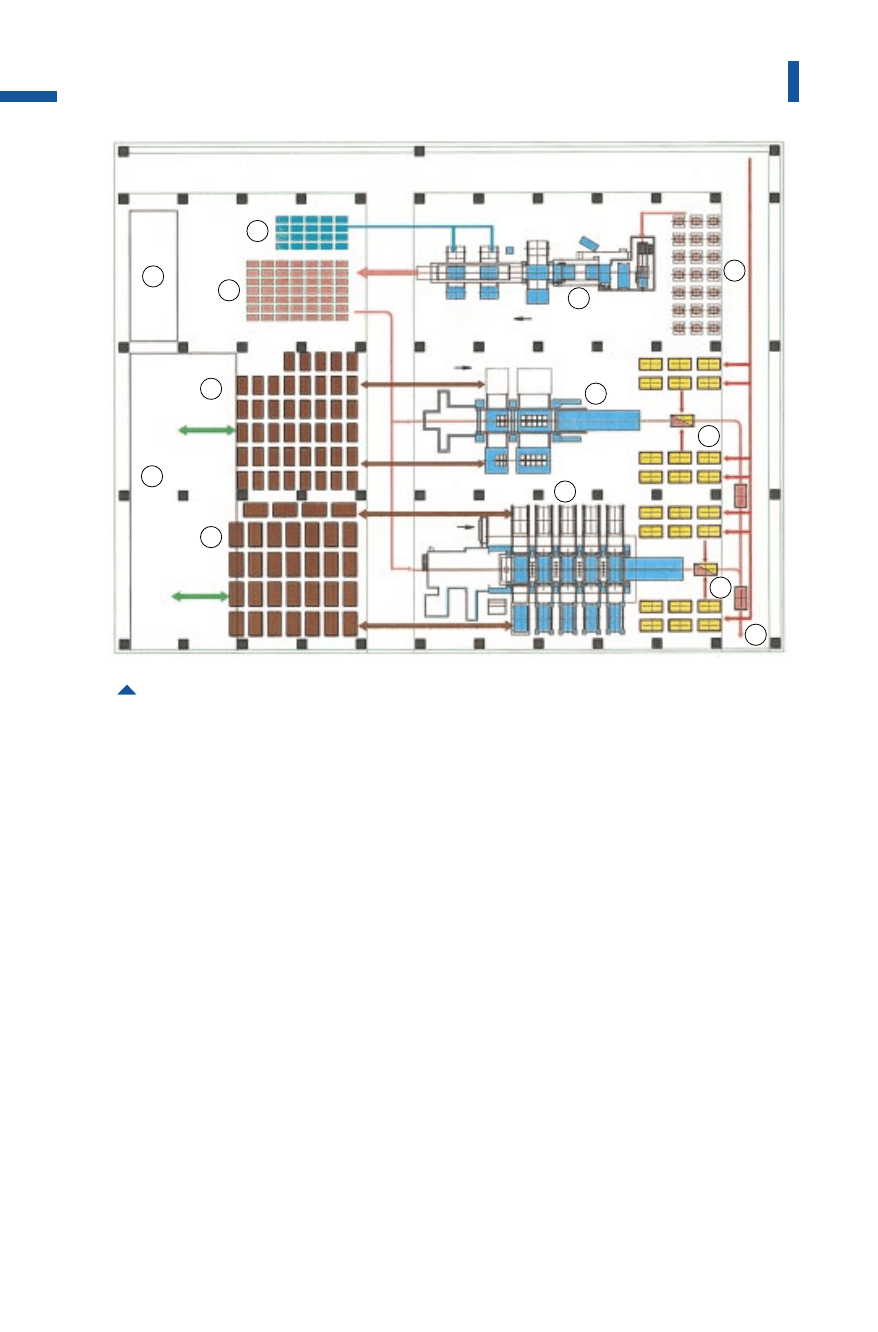
400
Sheet metal forming and blanking
parts, for example, for wrinkles and cracks (cf. Table 4.2.2) – and also
the testing of workpieces for dimensional accuracy using measuring
devices or gauges. However, this type of control process is both time-
consuming and labor intensive, and is generally only used in the case
of large, complex workpieces such as body panels or for random sam-
pling of smaller parts.
Where small punched parts are involved, the preferred system is one
of on-line controls in which quality assurance is integrated in the man-
ufacturing process itself, i.e. in the press. This permits monitoring of
each individual part and of process parameters such as die wear.
Visual inspections or workpiece gauging are increasingly being
replaced by optoelectronic and image processing systems. Simple opto-
Fig. 4.9.6 Layout of a stamping plant with material flow
1 coil storage; 2 blanking line; 3 intermediate pallet storage;
4 intermediate blank storage; 5 tri-axis transfer press; 6 die storage for 5;
7 racks for finished parts for 5; 8 crossbar transfer press; 9 die storage for 8;
10 racks for finished parts for 8; 11 to intermediate finished part storage;
12 offices and recreation facilities; 13 die repair and cleaning
1
2
5
7
8
10
11
9
6
4
12
3
13
Metal Forming Handbook / Schuler (c) Springer-Verlag Berlin Heidelberg 1998
